Particle Physics: An Extensive and Detailed Exploration
Particle physics delves into the fundamental constituents of matter and the forces that govern their interactions. It moves beyond the scale of atoms explored in atomic physics and even nuclear physics, to examine the subatomic world of quarks, leptons, and gauge bosons. These particles and their interactions form the basis of the physics that describes the universe at its most fundamental level, making modern physics indispensable in our quest for a unified understanding of nature.
The building blocks of matter, known as fermions, include quarks and leptons, which combine to form protons, neutrons, and electrons. In contrast, bosons are the force carriers responsible for mediating the fundamental forces of nature—gravity, electromagnetism, the weak nuclear force, and the strong nuclear force. These forces not only shape the behavior of matter but also govern high-energy interactions observed in accelerators and cosmic phenomena.
To comprehend these interactions, physicists rely heavily on quantum field theory, which merges quantum mechanics and special relativity into a consistent framework. This theory underpins the Standard Model of particle physics and provides the mathematical language to describe particle creation, annihilation, and exchange processes. Such phenomena are tightly connected to principles of quantum mechanics like wave functions, superposition, and entanglement.
Experimental evidence for these principles comes from various subfields. For instance, nuclear fission and nuclear fusion are manifestations of particle rearrangements and energy release at the nuclear level. Similarly, nuclear reactions often involve particle exchanges and transformations that help verify predictions from quantum theories.
Radioactive decay processes such as alpha, beta, and gamma emission, explained on the page about radioactivity and isotopes, further illustrate particle interactions at play within the atomic nucleus. These processes are deeply influenced by Heisenberg’s uncertainty principle, which imposes limits on simultaneously knowing a particle’s position and momentum.
Particle behavior also draws on concepts like wave-particle duality and quantum tunneling, both of which are fundamental to interpreting particle collision outcomes and barrier penetration probabilities. These effects are vital not just in subatomic experiments but also in the stability of stars and the working of nuclear technologies.
The origins of particle physics can be traced through our evolving understanding of the structure of the atom and refinements in quantum numbers and electron configuration. The development of statistical mechanics and insights from relativity have also contributed to the theoretical infrastructure of this field.
Today’s particle physics remains intertwined with interdisciplinary fields such as condensed matter physics, offering models that parallel particle interactions in solid-state systems. From the Higgs boson to neutrino oscillations, the field continues to push the frontiers of knowledge, firmly rooted in the heritage of physics as a whole.
As experimental methods advance, particle physics finds new relevance in practical applications ranging from medical imaging and cancer therapy using particle beams, to the use of high-energy detectors in security and material analysis. Research in neutrino physics, dark matter, and supersymmetry extends the boundaries of known physics, challenging scientists to refine or revise the Standard Model. Facilities such as the Large Hadron Collider (LHC), and future initiatives like the Future Circular Collider (FCC) and International Linear Collider (ILC), aim to unlock these mysteries by probing higher energies and rarer phenomena.
Moreover, advances in detector technology and data processing contribute to cross-disciplinary innovations. Particle physicists work hand-in-hand with computer scientists and data analysts to handle the massive datasets generated during collisions. These collaborations have led to developments such as the World Wide Web and breakthroughs in grid computing.
Educationally, particle physics serves as a vital gateway for students entering the world of theoretical and experimental research. It sharpens mathematical thinking, cultivates a deep understanding of nature’s laws, and inspires the next generation of innovators. Its concepts fuel curiosity, from understanding the origin of mass to exploring the early universe, making it a cornerstone of physics education and a symbol of humankind’s relentless pursuit of knowledge.
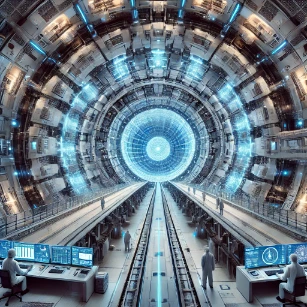
This artist’s impression of the Future Circular Collider showcases a colossal, next-generation particle accelerator envisioned to surpass the energy capabilities of the LHC. The image features a highly symmetrical underground tunnel lined with superconducting magnets and glowing detector arrays, emphasizing its immense scale and technological sophistication. Scientists and engineers are shown operating advanced control stations and monitoring systems along the beamline, highlighting the human element in high-energy physics research. The central vanishing point draws attention to the collider’s core, symbolizing the quest to explore deeper layers of matter and uncover new fundamental particles.

This conceptual rendering of the International Linear Collider illustrates a vast, ultra-modern linear tunnel engineered for high-precision particle collisions. The elongated design emphasizes straight, opposing beamlines converging toward a radiant interaction point, symbolizing the moment of electron-positron annihilation. Surrounding the beamline are sleek superconducting modules and electromagnetic structures, representing cutting-edge accelerator technology. The tunnel’s reflective symmetry and luminous focal point convey the ILC’s role in probing the Higgs boson and uncovering physics beyond the Standard Model with unparalleled clarity.
Table of Contents
The Standard Model of Particle Physics
The Standard Model stands as one of the crowning achievements in modern science, providing a comprehensive and mathematically robust framework to explain the behavior and interactions of all known elementary particles—except gravity. This model has withstood decades of experimental tests, from particle accelerators like the LHC to deep-space observations, confirming its predictions with astonishing precision. It is the result of collaborative work among thousands of physicists and has become the cornerstone of theoretical and experimental particle physics. The Standard Model not only categorizes elementary particles but also outlines the principles behind their interactions through force carriers, offering profound insights into the inner workings of the universe.
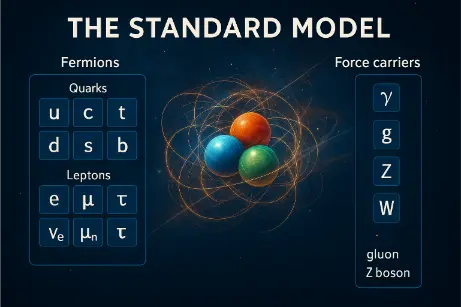
This digital illustration depicts the Standard Model in a structured layout. On the left, quarks and leptons are arranged into generational blocks under the label “Fermions.” On the right, force carriers—such as the photon, gluon, and W/Z bosons—are labeled under “Force carriers.” At the center, a vivid representation of a proton or neutron shows three colored quarks surrounded by swirling gluon fields. The entire composition is set against a cosmic, star-filled background, underscoring the universal relevance of the Standard Model.
Despite its successes, the Standard Model is not the final theory. It leaves several mysteries unresolved, such as the nature of dark matter and dark energy, the matter-antimatter asymmetry in the universe, and the integration of gravity with quantum mechanics. Nonetheless, it remains the best tested theory in science, forming a launching pad for new physics beyond its limits.
Fundamental Particles
a. Fermions (Matter Particles)
Fermions are the essential building blocks of matter. According to the Pauli Exclusion Principle, no two identical fermions can occupy the same quantum state simultaneously. This principle explains the complex structure of atoms and the stability of matter itself. Fermions are divided into two families: quarks and leptons. These particles differ in mass, charge, and interaction with forces, but all play critical roles in forming the observable universe.
- Quarks:
- Quarks are never found in isolation under normal conditions due to a phenomenon known as color confinement. They combine to form hadrons such as protons and neutrons, which in turn make up atomic nuclei.
- There are six types or “flavors” of quarks: up (u), down (d), charm (c), strange (s), top (t), and bottom (b). These names are arbitrary and do not correspond to physical characteristics.

This educational illustration depicts the six known types or “flavors” of quarks, a foundational concept in quantum chromodynamics (QCD). Each quark type is represented by a distinct color and symbol: up (u), down (d), charm (c), strange (s), top (t), and bottom (b). The visual emphasizes their classification and pairing structure, commonly used in particle physics diagrams. These quarks carry a property known as color charge, and interact via the strong nuclear force mediated by gluons, never existing freely due to the principle of color confinement.
- Quarks interact through the strong nuclear force, mediated by gluons, and possess a property known as “color charge,” which is unrelated to visible color but crucial for quantum chromodynamics (QCD).
- Leptons:
- Leptons are particles that do not participate in the strong interaction. They include three charged particles—electron (e), muon (μ), and tau (τ)—and their corresponding neutrinos: νₑ, ν_μ, and ν_τ.
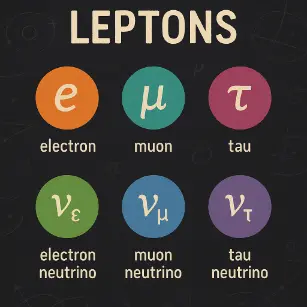
- Neutrinos are incredibly elusive, with extremely small masses and weak interactions. Billions of neutrinos pass through your body every second, undetected.
- The discovery of neutrino oscillations—evidence that neutrinos have mass—was a major finding that indicated the need to extend the Standard Model.
b. Bosons (Force Carriers)
Bosons are responsible for mediating the fundamental forces of nature. Unlike fermions, multiple bosons can exist in the same quantum state, enabling phenomena like lasers and superconductivity. These particles ensure that matter particles interact according to the rules defined by the Standard Model.
- Photon (γ): The quantum of the electromagnetic field, responsible for electromagnetic interactions. It is massless and travels at the speed of light.
- W and Z Bosons: These heavy particles mediate the weak nuclear force. Their massive nature is why weak interactions are short-range. The W bosons are charged, while the Z boson is neutral.
- Gluon (g): These massless bosons carry the strong force, binding quarks inside protons and neutrons. Gluons themselves carry color charge and can interact with each other, unlike photons.
- Higgs Boson (H⁰): The last particle to be discovered (in 2012), it gives mass to other elementary particles via the Higgs mechanism, a cornerstone of the Standard Model.
- Graviton (hypothetical): While not part of the Standard Model, it is theorized to mediate gravity. However, its existence remains unconfirmed due to the extreme weakness of gravitational interactions at the quantum level.
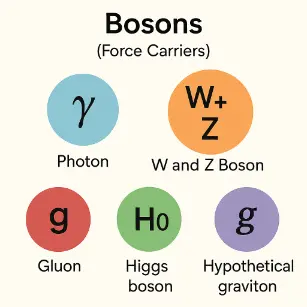
This graphic illustrates the key bosons responsible for mediating fundamental forces in the universe. The photon (γ) governs electromagnetic interactions and is massless. The W⁺, W⁻, and Z bosons mediate the weak nuclear force and are heavy, limiting its range. The gluon (g) carries the strong force and uniquely interacts with itself via color charge. The Higgs boson (H⁰), discovered in 2012, enables particles to acquire mass. Lastly, the graviton, though hypothetical and not part of the Standard Model, is postulated to mediate gravity. Each boson plays a unique role in the Standard Model or beyond, underpinning physical interactions.
Fundamental Forces
All known physical phenomena arise from just four fundamental forces. The Standard Model successfully integrates three of them, offering deep insight into particle behavior and interactions. These forces operate over vastly different scales and strengths, yet they form the cohesive fabric of the universe.
- Strong Nuclear Force:
- The strongest of the four forces, yet it acts over the shortest range—about the size of an atomic nucleus.
- It binds quarks together via gluons to form hadrons and is responsible for holding protons and neutrons inside nuclei despite the repulsive electromagnetic force between protons.
- Described by the theory of Quantum Chromodynamics (QCD), which explains how color charge works in the interaction of quarks and gluons.
- Electromagnetic Force:
- Acts between all charged particles and is responsible for electricity, magnetism, light, and chemical bonding.
- Described by Quantum Electrodynamics (QED), the most precisely tested theory in physics.
- Photons are its mediators, and the force operates over infinite distances but weakens with the square of the distance.
- Weak Nuclear Force:
- Responsible for certain types of radioactive decay, such as beta decay, and plays a vital role in nuclear fusion within stars.
- It acts on all fermions and is essential for processes that change one type of quark into another.
- Despite its name, it is much stronger than gravity but has a very short range due to the massive W and Z bosons.
- Gravity:
- The weakest of all fundamental forces but acts over infinite distances and governs the structure of the cosmos.
- It is not yet unified with the Standard Model, and a quantum theory of gravity remains one of the biggest open problems in theoretical physics.
- General Relativity, Einstein’s theory, currently provides the best description of gravity on macroscopic scales, such as planets, stars, and galaxies.
Beyond the Standard Model
While the Standard Model of particle physics has proven remarkably successful in explaining the known elementary particles and their interactions, it is not the ultimate theory of everything. It does not account for certain cosmic and quantum phenomena, prompting physicists to look beyond its elegant yet limited framework. The universe is known to be far more complex, and a wide range of observations—including dark matter, dark energy, and the imbalance between matter and antimatter—demand theoretical explanations that lie outside the boundaries of the Standard Model.
To address these gaps, researchers are exploring a variety of advanced theories and conducting cutting-edge experiments in laboratories around the world. From precision measurements to high-energy collisions, these efforts are probing deeper into the structure of the universe, testing hypotheses that include new particles, symmetries, and forces. The following topics represent some of the most compelling avenues in the quest to uncover new physics beyond the Standard Model.
Higgs Boson
- Predicted: The Higgs boson was first theorized in 1964 by Peter Higgs and others as a crucial component of the Standard Model. Its role is to explain how fundamental particles acquire mass without violating gauge symmetry.
- Discovered: Nearly five decades later, in 2012, the Higgs boson was experimentally confirmed by the ATLAS and CMS collaborations at CERN’s Large Hadron Collider (LHC). This discovery marked a monumental moment in science, earning the 2013 Nobel Prize in Physics.
- Higgs Field: The Higgs boson is a quantum excitation of the Higgs field, an invisible field that permeates all of space. As particles move through this field, they acquire mass via spontaneous symmetry breaking, similar to how a spoon moves through a viscous medium.
- Open Questions: While the Higgs boson was found, many aspects remain unresolved—such as whether it is a lone scalar particle or part of a larger mechanism involving multiple Higgs fields, as predicted by supersymmetry and other extensions.
- Beyond the Standard Model: Precision studies of the Higgs boson’s properties, including its decay channels and self-interactions, are a major focus of current research, as they may reveal new physics hidden within the Higgs sector.
Dark Matter
- Evidence: The presence of dark matter is inferred from gravitational effects on visible matter, gravitational lensing, and the rotation curves of galaxies. Without it, galaxies would not hold together under the force of gravity as observed.
- Nature: Dark matter constitutes about 27% of the universe’s energy density, yet it does not emit, absorb, or reflect light, making it invisible to traditional detectors. Its composition remains one of the biggest open questions in cosmology.
- Candidates:
- WIMPs (Weakly Interacting Massive Particles): Hypothetical particles that interact via the weak force and gravity, but not electromagnetically.
- Axions: Ultra-light particles proposed as a solution to the strong CP problem in quantum chromodynamics (QCD), potentially comprising cold dark matter.
- Sterile Neutrinos: A hypothesized type of neutrino that does not interact via any of the known forces except gravity, providing another plausible dark matter candidate.
- Detection: Many experiments aim to detect dark matter through direct, indirect, or collider-based methods. Notable direct detection projects include XENON1T and LUX-ZEPLIN, which use ultra-sensitive detectors to observe rare interactions between dark matter particles and atomic nuclei.
- Future Prospects: Discovering dark matter would not only confirm the existence of an entirely new sector of particles but could also unlock a deeper understanding of the universe’s structure and origin.
Why Study Particle Physics
Understanding the Fundamental Constituents of Matter
Studying particle physics provides students with the opportunity to explore the very foundation of the material universe. At the heart of this field is the investigation of fundamental particles such as quarks, leptons, and gauge bosons—entities that constitute everything from atoms to stars. By understanding these particles and the forces that govern them, students uncover the rules that nature follows at its smallest scales. These principles help explain why atoms form, how chemical bonds arise, and how energy transforms into matter.
Beyond learning the identities of these particles, students also explore the mathematical frameworks that describe their behavior, including quantum mechanics and quantum field theory. These frameworks help answer questions such as: What gives mass to matter? Why do particles have different charges? How does energy transform into particles? This foundational knowledge enables learners to grasp the elegance of nature’s design while acquiring tools to model and predict physical systems across various scientific domains.
The Standard Model and Its Components
The Standard Model is one of the most rigorously tested theories in physics and serves as the backbone of particle physics. It describes the electromagnetic, weak, and strong forces, and classifies all known elementary particles into families and generations. Students who study the Standard Model gain a deep understanding of the subatomic structure of the universe and develop the skills to apply symmetry principles, conservation laws, and gauge theories to solve physical problems.
Moreover, the Standard Model acts as a gateway to more advanced physics topics. Its successes are numerous—from predicting the existence of particles like the W and Z bosons to guiding experiments that led to the discovery of the Higgs boson. However, it also provides a roadmap for what lies beyond, as it leaves out gravity, dark matter, and dark energy. Students gain an appreciation of both what we know and what we still need to discover.
Experimental Techniques and Large-Scale Collaborations
Students of particle physics do not merely engage in theoretical speculation; they also learn about the powerful tools and technologies used to test those theories. From particle accelerators like the LHC to detectors that capture subatomic collisions, these instruments allow scientists to recreate the conditions of the early universe. Students become familiar with how these machines operate, how data is collected and analyzed, and how experimental design influences scientific outcomes.
Participation in international research collaborations teaches students soft skills like communication, project management, and cultural cooperation. They gain exposure to how large scientific communities share knowledge, resolve disagreements, and execute large-scale experiments involving hundreds or thousands of contributors from around the world. These experiences foster teamwork, precision, and scientific integrity—preparing students for careers in academia, industry, or any globally integrated research environment.
Applications Beyond Fundamental Research
While particle physics is primarily driven by the pursuit of fundamental knowledge, its real-world applications are both numerous and impactful. The technologies developed in the course of studying subatomic particles have found their way into medicine, security, computing, and engineering. Students gain firsthand insight into how basic research leads to transformative tools and solutions in everyday life.
One such example is Positron Emission Tomography (PET), a medical imaging technique that uses antimatter particles to visualize metabolic activity in tissues. This diagnostic method is widely used in oncology, cardiology, and neurology. Similarly, proton therapy, a direct product of particle accelerator research, allows for precise targeting of cancerous tumors with minimal damage to surrounding tissues.
Students also explore technologies like Magnetic Resonance Imaging (MRI), which relies on quantum spin phenomena rooted in the same principles studied in quantum and particle physics. In the field of information technology, particle physics has spurred innovations in quantum computing and data science due to the need for massive data processing and advanced algorithms.
These contributions exemplify the ripple effect of curiosity-driven research. By engaging in particle physics, students do not only train to be theorists or experimenters; they equip themselves with the analytical, computational, and technical skills applicable to a wide array of high-tech careers. They also cultivate a mindset that values long-term exploration and interdisciplinary problem-solving.
Pathway to Theoretical and Cosmological Frontiers
For students with a passion for deep conceptual thinking, particle physics offers a gateway to some of the most profound theoretical and cosmological questions ever asked. How did the universe begin? What is the nature of spacetime? Are there hidden dimensions or parallel universes? By studying this field, learners find themselves at the intersection of quantum mechanics, general relativity, and cosmology.
Particle physics provides a foundation for exploring supersymmetry, grand unified theories (GUTs), and string theory—all of which aim to unify the fundamental forces and explain why the universe has the structure it does. Students investigate hypotheses that extend beyond the Standard Model, such as extra dimensions, quantum gravity, and multiverse theories. These pursuits connect with larger frameworks in cosmology and astrophysics, revealing deep links between particle-scale phenomena and cosmic evolution.
Such exploration trains students to think abstractly, test theoretical models against observational data, and participate in scientific debates about the nature of existence. They learn to balance creativity with empirical rigor—an intellectual skill set that benefits all realms of advanced scientific inquiry.
Three Transformative Discoveries in Particle Physics
Particle physics is a field defined not only by abstract theories but also by monumental experimental breakthroughs that have reshaped our understanding of the universe at its most fundamental level. Over the past few decades, several discoveries have stood out as turning points—moments when the invisible fabric of reality was made visible through human ingenuity, collaboration, and technological prowess.
This section highlights three such landmark achievements. First, the discovery of the Higgs boson in 2012 confirmed a critical missing piece of the Standard Model, demonstrating how particles acquire mass via interaction with the Higgs field. Second, the phenomenon of neutrino oscillations—where neutrinos switch identities—challenged assumptions about massless particles and pointed to physics beyond the Standard Model. Third, the theoretical and experimental confirmation of quark confinement gave rise to Quantum Chromodynamics (QCD), a robust framework describing the behavior of quarks and gluons inside hadrons. Each discovery not only answered longstanding questions but also opened new avenues for inquiry into the deepest layers of physical law.
Transformative Discovery 1: The Higgs Boson (2012)
The discovery of the Higgs boson in 2012 marked a monumental turning point in the field of particle physics. Often described as the final missing piece of the Standard Model, this elusive particle had been theorized for nearly half a century before it was finally observed at CERN’s Large Hadron Collider (LHC). The Higgs boson is not just another subatomic particle—it represents a profound insight into how the universe itself is structured. Its confirmation validated the existence of the Higgs field, a fundamental aspect of modern physics that explains how particles acquire mass.
Theoretical Origins: Why the Higgs Boson Was Needed
In the 1960s, physicists were grappling with a major puzzle: how do fundamental particles acquire mass? Gauge theories like quantum electrodynamics worked brilliantly for describing massless particles, but failed when applied to particles such as the W and Z bosons, which were known to be massive. The breakthrough came in 1964 when several groups of physicists—most notably Peter Higgs, François Englert, and Robert Brout—proposed a mechanism by which particles could gain mass through interaction with a pervasive quantum field.
This became known as the Higgs mechanism. It postulated the existence of an invisible energy field—the Higgs field—that permeates the universe. As particles pass through this field, they interact with it and, depending on the strength of this interaction, acquire mass. The Higgs boson is the quantum excitation of this field, much like a photon is the quantum of the electromagnetic field. This theory elegantly solved the mass problem, but the Higgs boson itself remained undetected due to the extreme energy required to produce it.
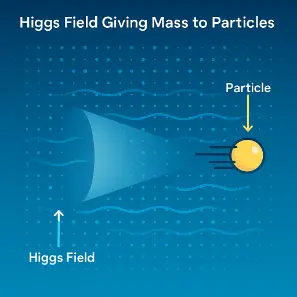
This digital illustration offers a conceptual view of the Higgs Field, depicted as a glowing, semi-viscous energy medium permeating all space. A lone particle is shown entering this field from the left, with motion trails indicating deceleration as it interacts with the field. This interaction represents how particles gain mass—not by carrying it inherently, but by resisting movement through the omnipresent Higgs Field. This visualization captures the essence of the Higgs mechanism as predicted by the Standard Model and confirmed by experiments at the Large Hadron Collider (LHC) in 2012.
Engineering a Discovery: The Large Hadron Collider
To detect the Higgs boson, physicists needed to reach energy levels far beyond those available in previous particle accelerators. This led to the development of the Large Hadron Collider (LHC) at CERN. Completed in 2008, the LHC is a 27-kilometer ring buried beneath the Franco-Swiss border. It accelerates protons to near light speed before colliding them head-on, recreating conditions similar to those just moments after the Big Bang.
Two massive experiments—ATLAS and CMS—were specifically designed to detect signs of the Higgs boson. Each experiment had thousands of collaborators from over 100 countries and used sophisticated detectors to analyze particle debris from billions of collisions. The challenge was not just to observe new particles, but to distinguish the Higgs signal from an overwhelming background of known processes.
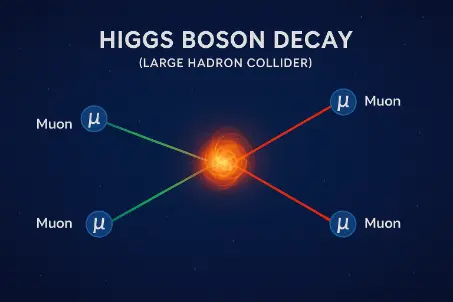
This futuristic scientific illustration simulates a particle collision event inside the Large Hadron Collider (LHC), showcasing the decay of a Higgs boson into observable daughter particles. The symmetrical rings represent layers of the ATLAS or CMS detectors, capturing collision debris as colored trails that spiral outward. Such visualizations reflect how the 2012 discovery was made—not by directly observing the Higgs itself, but by analyzing these decay products and their energy signatures. The image underscores the complexity and elegance of high-energy physics experiments, highlighting the monumental achievement in confirming the Higgs boson’s existence.
The Historic Announcement: July 4, 2012
On July 4, 2012, CERN announced that both ATLAS and CMS had independently observed a new boson with a mass of approximately 125 GeV. The statistical significance of the data surpassed the 5-sigma threshold, meaning the chance of a false signal was less than one in 3.5 million. The properties of this particle matched those predicted for the Higgs boson, confirming a key prediction of the Standard Model. Peter Higgs, in attendance at the announcement, was visibly moved—his theoretical work from 48 years earlier had become reality.
In 2013, the Nobel Prize in Physics was awarded jointly to Peter Higgs and François Englert for their theoretical discovery. The experimental teams at CERN were also internationally recognized, though Nobel rules limit the number of recipients per prize. This announcement represented not just a single achievement but a crowning moment for decades of theoretical and experimental efforts in particle physics.
Scientific Significance: Completing the Standard Model
The discovery of the Higgs boson completed the roster of particles predicted by the Standard Model, which now had an experimentally validated mechanism for mass generation. This success reinforced the robustness of the Standard Model and confirmed that spontaneous symmetry breaking via the Higgs mechanism is a real phenomenon. It resolved one of the most crucial gaps in our understanding of particle interactions.
However, this discovery also raised new questions. Why does the Higgs field have the specific strength it does? Could the Higgs boson be part of a larger system, such as a multiplet in supersymmetry? Is the Higgs boson truly elementary, or could it be a composite of more fundamental constituents? These questions have become focal points for further research and experimentation.
Impact on Experimental Physics and Technology
Detecting the Higgs boson was not just a scientific triumph but also an engineering marvel. The success of the LHC experiments highlighted the importance of international scientific collaboration, precision instrumentation, and advanced computing. The detectors used in ATLAS and CMS were technological feats capable of measuring events at the subatomic level with incredible accuracy and speed.
The computing infrastructure built to analyze LHC data—known as the Worldwide LHC Computing Grid—remains one of the largest distributed computing systems in the world. This infrastructure supports not only particle physics but also fields like climate modeling, genomics, and financial analytics. Technologies such as superconducting magnets, cryogenic systems, and silicon detectors have found applications in medical imaging, materials research, and even airport security.
Cultural and Educational Impact
The Higgs boson captured the public imagination in unprecedented ways. Often sensationalized as the “God Particle” (a term disliked by many physicists), it symbolized humanity’s quest to understand the deepest mysteries of existence. Media coverage, documentaries, and public lectures brought particle physics into mainstream discourse, raising awareness about the role of fundamental science in technological progress.
In classrooms, the Higgs boson became a powerful teaching tool. Its discovery illustrated how mathematical theories, experimental verification, and large-scale collaboration converge in modern science. Students around the world were inspired to pursue studies in physics, mathematics, and engineering, recognizing that the next big breakthrough could be theirs to make.
Continuing the Journey: Precision Higgs Physics
Since 2012, the focus of Higgs-related research has shifted to precision measurements. Physicists aim to test the particle’s properties with exquisite detail to uncover potential deviations from Standard Model predictions. These measurements include the Higgs self-coupling (how it interacts with itself), its rare decay modes, and its interaction strengths with other particles.
Future projects like the High-Luminosity LHC (HL-LHC) and the International Linear Collider (ILC) are designed to extend this work. The HL-LHC will increase data collection by a factor of 10, enabling rare processes to be studied. The ILC, by colliding electrons and positrons rather than protons, will provide a cleaner environment to study the Higgs with minimal background noise.
A Symbol of Scientific Possibility
The discovery of the Higgs boson stands as a testament to the power of human curiosity, ingenuity, and collaboration. It embodies the essence of science: developing elegant theories, building the tools to test them, and embracing uncertainty as a path to discovery. As the first fundamental scalar particle ever found, the Higgs continues to challenge physicists to think beyond the Standard Model and toward the next paradigm of understanding.
For students and educators, it provides a compelling story of perseverance and achievement. For society, it offers an example of how basic research can yield transformative insights—and practical benefits—far beyond its original intent. Most importantly, it reminds us that even the most abstract ideas, pursued with determination and clarity, can one day change the way we see the universe.
Transformative Discovery 2: Neutrino Oscillations
Neutrino oscillations represent one of the most profound discoveries in modern physics, fundamentally reshaping our understanding of elementary particles and challenging long-held assumptions within the Standard Model. Once thought to be massless, neutrinos were revealed to have mass through a remarkable quantum phenomenon that allows them to switch between different types—or “flavors”—as they travel. This discovery not only expanded the boundaries of particle physics but also offered key insights into the structure and evolution of the universe itself.
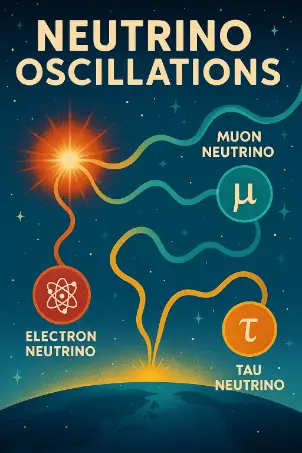
This vibrant scientific diagram illustrates the phenomenon of neutrino oscillation—a key discovery that overturned the assumption that neutrinos were massless. The image shows neutrinos propagating through space, transitioning between their three known flavors: electron (νₑ), muon (ν_μ), and tau (ν_τ). The oscillation is visualized as smooth wave-like transitions between colors, symbolizing quantum superposition and flavor mixing. This visual encapsulates the surprising realization that neutrinos, once thought to be ghostlike and massless, do in fact have finite mass, leading to a major revision of the Standard Model.
The Elusive Nature of Neutrinos
Neutrinos are among the most abundant particles in the universe, yet they are notoriously difficult to detect. They interact only via the weak nuclear force and gravity, making their interaction cross-section extremely small. Billions of neutrinos pass through your body every second without leaving a trace. These ghost-like particles were first proposed by Wolfgang Pauli in 1930 to explain missing energy in beta decay, and were later confirmed experimentally in 1956 by Clyde Cowan and Frederick Reines.
The Standard Model originally treated neutrinos as massless particles, primarily because no mass had been measured and incorporating mass terms posed theoretical complications. However, the behavior of neutrinos observed in astrophysical and terrestrial experiments began to suggest otherwise. If neutrinos could oscillate between flavors—electron, muon, and tau—then they must have nonzero mass. This idea, though controversial at first, would eventually revolutionize particle physics.
The Solar Neutrino Problem
One of the earliest hints of neutrino oscillations came from the solar neutrino problem. In the 1960s, experiments led by Raymond Davis Jr. in the Homestake mine in South Dakota detected only about one-third of the expected number of electron neutrinos coming from the Sun. According to nuclear fusion models of stellar energy production, the Sun should emit a steady flux of electron neutrinos. The discrepancy puzzled physicists for decades and led to debates over the accuracy of solar models and neutrino detection techniques.
This conundrum was resolved only when physicists realized that electron neutrinos produced in the Sun might be changing into muon or tau neutrinos en route to Earth—flavors that early detectors were not designed to identify. This elegant solution required neutrinos to have mass, contradicting the Standard Model but aligning perfectly with the phenomenon of neutrino oscillation.
Atmospheric Neutrino Experiments
Further evidence came from atmospheric neutrino experiments, particularly the work conducted by the Super-Kamiokande detector in Japan. In 1998, this experiment observed a deficit in the number of muon neutrinos arriving from the atmosphere, particularly those that had traveled long distances through the Earth. This directional dependence indicated that neutrinos were oscillating between flavors during flight. The results provided irrefutable evidence for neutrino oscillations and thus for neutrino mass.
The Super-Kamiokande findings were a breakthrough. They demonstrated that neutrinos change identity as they propagate, a process dependent on the mass differences and mixing angles between the three flavors. These results earned widespread acclaim and were instrumental in reshaping our view of neutrinos as dynamic and complex particles rather than static entities.
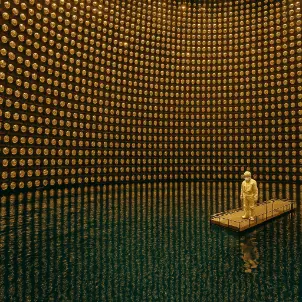
This high-resolution image captures the interior of the Super-Kamiokande neutrino detector in Japan—one of the most significant observatories for studying neutrino oscillations. The structure consists of an enormous cylindrical tank lined with thousands of photomultiplier tubes (PMTs) that detect the faint flashes of Cherenkov radiation produced when neutrinos interact with water molecules. The glowing symmetry and depth of the chamber evoke the scale and sensitivity required for detecting these elusive particles. This facility provided groundbreaking evidence that neutrinos change flavors as they travel, and thus must have mass, fundamentally reshaping our understanding of particle physics.
The Mechanics of Neutrino Oscillations
Neutrino oscillation is a quantum mechanical effect arising because the three known neutrino flavors are not identical to the three neutrino mass eigenstates. Instead, flavor states are linear combinations of mass states. As a neutrino travels, the phases of these mass components evolve at different rates, leading to interference effects that cause the neutrino to oscillate between flavors.
This phenomenon can be described mathematically using the PMNS matrix (Pontecorvo–Maki–Nakagawa–Sakata matrix), analogous to the CKM matrix in quark mixing. The probability that a neutrino of a given flavor will be detected as a different flavor depends on factors such as the squared mass differences (∆m2), the energy of the neutrino, and the distance traveled.
The discovery that at least two neutrinos have different masses implies that the absolute mass scale of neutrinos, while still unknown, is nonzero. This small but significant mass has enormous implications for particle physics and cosmology.
Experimental Milestones
Following Super-Kamiokande, a series of experiments solidified the case for neutrino oscillations:
- SNO (Sudbury Neutrino Observatory): Located in Canada, SNO confirmed that solar electron neutrinos were indeed converting into other flavors, solving the solar neutrino problem conclusively.
- K2K and MINOS: Long-baseline experiments that studied neutrino beams over hundreds of kilometers, confirming flavor transformation during travel.
- KamLAND: Observed oscillations in antineutrinos from nuclear reactors, supporting the oscillation model and measuring ∆m2 values with high precision.
- IceCube: A massive detector in Antarctic ice that observes high-energy astrophysical neutrinos and continues to search for oscillation signatures at extreme energies.
Each of these experiments contributed unique data to determine the oscillation parameters—mass differences and mixing angles—and collectively established oscillations as a universal phenomenon among neutrino species.
Implications for the Standard Model
The discovery of neutrino oscillations forced physicists to extend the Standard Model. Mass terms had to be added, requiring a mechanism for neutrino mass generation. One possibility is the seesaw mechanism, which posits the existence of very heavy right-handed neutrinos that couple weakly to the left-handed neutrinos we observe. This theory also ties into grand unified theories and leptogenesis, a proposed explanation for the matter-antimatter asymmetry in the universe.
Additionally, the PMNS matrix includes a CP-violating phase, which could account for the dominance of matter over antimatter. If neutrinos violate CP symmetry, it would be an entirely new source of asymmetry not yet observed in any other part of the Standard Model. Experiments are actively searching for evidence of this behavior.
Future of Neutrino Research
Several next-generation experiments aim to refine our understanding of neutrino properties. The Deep Underground Neutrino Experiment (DUNE), under construction in the United States, will use a high-intensity neutrino beam to measure CP violation and mass ordering. JUNO (Jiangmen Underground Neutrino Observatory) in China seeks to determine the mass hierarchy by observing reactor neutrinos with unprecedented precision.
Additionally, researchers are attempting to determine whether neutrinos are Dirac or Majorana particles. If neutrinos are Majorana, they are their own antiparticles—a possibility that would have deep implications for particle physics and cosmology. The search for neutrinoless double beta decay is ongoing in experiments such as GERDA and EXO, which could resolve this question.
Cosmological and Astrophysical Significance
Neutrinos play a key role in the evolution of the universe. Their small but nonzero masses affect the formation of large-scale structures such as galaxies and galaxy clusters. Precision cosmological observations, such as those from the Planck satellite, constrain the sum of neutrino masses, providing complementary information to particle experiments.
In supernova explosions, neutrinos carry away most of the energy, helping drive the shock wave that disperses stellar material. Observing neutrinos from a galactic supernova would offer insights into both stellar physics and neutrino properties. The 1987A supernova already provided a hint of this capability, and future observations may yield a wealth of new data.
Educational and Cultural Impact
Neutrino research has had a transformative impact on science education and public engagement. The idea that particles can morph into other particles through quantum interference is both counterintuitive and intellectually stimulating. It provides an excellent case study for illustrating the predictive power of quantum mechanics and the role of experimentation in overturning theoretical assumptions.
For students, learning about neutrino oscillations introduces key concepts such as mass eigenstates, quantum superposition, and weak interactions. It also demonstrates the global and interdisciplinary nature of scientific research, with collaborations spanning continents and involving thousands of scientists, engineers, and data analysts.
Conclusion: A Window into New Physics
The discovery of neutrino oscillations was more than just a correction to the Standard Model—it was a portal to entirely new realms of physics. It exposed a hidden structure in the lepton sector, revealed the existence of neutrino mass, and opened the door to questions about the nature of matter, the origins of the universe, and the potential for physics beyond our current understanding.
As experiments continue to probe the neutrino sector, we move closer to unlocking the mysteries of mass, CP violation, and the early cosmos. Neutrinos, once considered nearly irrelevant, now stand at the heart of some of the most exciting questions in contemporary physics, offering both a challenge and an inspiration to future generations of scientists.
Quark Confinement and the Emergence of Quantum Chromodynamics (QCD)
The development and eventual confirmation of quark confinement and Quantum Chromodynamics (QCD) marks one of the most transformative achievements in particle physics. Unlike the more publicized discoveries of particles like the Higgs boson, the understanding of quarks as fundamental building blocks and the theory governing their interactions have reshaped our theoretical and experimental foundations. The conceptual leap that quarks are permanently confined and cannot exist in isolation led to a new perspective on the strong nuclear force, setting the stage for an entire subfield within the physics of fundamental particles.
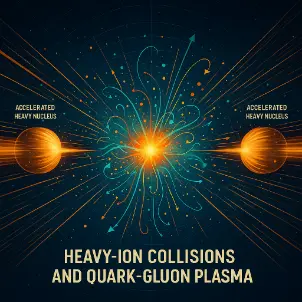
This vivid digital illustration portrays a conceptual visualization of quark-gluon plasma—a hot, dense soup of unbound quarks and gluons that existed microseconds after the Big Bang. The glowing filaments and radiating bursts symbolize the immense energy released during high-energy particle collisions, replicating conditions from the universe’s earliest moments. Such states have been briefly recreated in particle accelerators like the Relativistic Heavy Ion Collider (RHIC) and the ALICE experiment at the LHC. The image captures the primordial chaos and fluid-like behavior of this plasma, highlighting its significance in uncovering how matter as we know it emerged from a formless quantum field.
Theoretical Genesis of Quarks
The idea of quarks was first proposed in 1964 by Murray Gell-Mann and George Zweig as a classification tool to explain patterns among hadrons. These hypothetical entities—originally labeled as up, down, and strange—were assigned fractional electric charges, which were unlike anything previously observed. While useful for organizing hadronic states, quarks were initially considered mathematical constructs rather than physically real particles. Yet, as fermions, quarks soon became central to the deeper understanding of matter itself.
Deep Inelastic Scattering and Evidence for Substructure
Empirical support for the existence of quarks came from the deep inelastic scattering experiments at SLAC (Stanford Linear Accelerator Center) in the late 1960s. By firing high-energy electrons at protons and neutrons, physicists discovered scattering patterns that could not be explained by point-like particles alone. These patterns suggested that protons and neutrons were composed of smaller constituents—what Gell-Mann had called quarks. The results provided the first concrete indication that matter has an internal structure beyond the atomic nucleus, reshaping our notion of indivisibility in physics.
The Conundrum of Quark Confinement
Despite the growing acceptance of quarks, a major puzzle remained: quarks had never been observed in isolation. Unlike electrons or protons, no experiment had ever detected a free quark. This led to the principle of quark confinement—the idea that quarks are perpetually bound within hadrons by an immensely strong force that increases with distance. This is counterintuitive compared to electromagnetic forces, which weaken with distance. The theoretical breakthrough came when physicists realized that the force responsible for binding quarks behaves in a completely different manner than previously known forces.
Birth of Quantum Chromodynamics (QCD)
Quantum Chromodynamics emerged in the early 1970s as a non-Abelian gauge theory based on the SU(3) symmetry group. It proposed that quarks possess a property called color charge—analogous to electric charge but coming in three types (red, green, blue). The force-carrying particles in QCD are gluons, which not only mediate the strong force between quarks but also interact with each other. This self-interaction leads to a highly complex and confining field structure. The dynamics of color charge underlie phenomena such as color neutrality and the formation of mesons and baryons.
Asymptotic Freedom: The Key to Understanding QCD
One of the most counterintuitive features of QCD is asymptotic freedom, discovered by David Gross, Frank Wilczek, and David Politzer in 1973. As quarks come closer together (i.e., at higher energies), the strong force becomes weaker. This explained why quarks inside protons appear nearly free in high-energy collisions but are impossible to separate at lower energies. Asymptotic freedom was a revolutionary insight, providing mathematical justification for quark confinement and validating QCD as a true quantum field theory. This discovery earned the 2004 Nobel Prize in Physics.
Experimental Evidence for QCD
Several types of experiments have validated the predictions of QCD over the decades:
- Jet production in electron-positron annihilation: Events such as those at the LEP collider showed characteristic three-jet patterns consistent with gluon emission.
- Scaling violations in deep inelastic scattering: Deviations from the naive parton model confirmed QCD’s running coupling constant behavior.
- Lattice QCD: Computational simulations on supercomputers have produced theoretical hadron masses that agree with experimental values, giving non-perturbative insights into confinement and hadronization.
- Heavy ion collisions: Experiments at RHIC and the LHC created the quark-gluon plasma, a state of matter where quarks and gluons are deconfined, providing a glimpse of the early universe microseconds after the Big Bang.
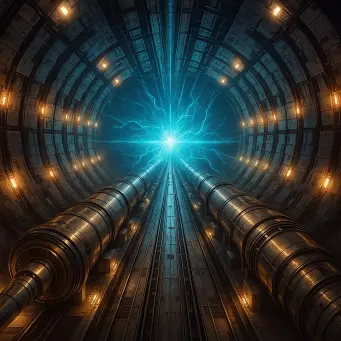
This computer-generated cutaway illustration depicts the ALICE (A Large Ion Collider Experiment) detector at CERN’s Large Hadron Collider. The detailed visualization shows the central collision chamber where lead ions are accelerated and smashed together at nearly the speed of light. At the point of impact, a fleeting drop of quark-gluon plasma forms—a primordial fluid that once filled the universe less than a microsecond after the Big Bang. Surrounding detection layers capture the behavior and decay patterns of emerging particles. This visual conveys how cutting-edge experiments probe the deepest structure of matter and recreate the extreme states that governed the universe’s earliest evolution.
Implications of Quark Confinement
Quark confinement challenges the traditional notion of particles as independent, measurable entities. Instead, QCD forces us to view quarks as permanently bound within hadrons. This has implications for everything from the structure of atomic nuclei to the origin of most visible mass in the universe, which comes from strong interaction energies rather than the intrinsic masses of quarks. The confinement phenomenon also plays a central role in modern approaches to hadron physics and exotic states of matter like tetraquarks and pentaquarks.
QCD in the Standard Model and Beyond
QCD forms a core part of the Standard Model, integrated with electroweak theory through the renormalization of quantum field theories. However, its complexity has also spurred research into phenomena beyond the Standard Model. The confinement scale, known as Lambda QCD, defines the energy at which perturbative methods break down. This boundary condition motivates new methods in theoretical physics and may connect with proposed phenomena like color superconductivity or beyond-standard exotic forces.
Modern Challenges and Research Frontiers
Although QCD is widely accepted, several questions remain open:
- Can confinement be derived from first principles in an analytical way?
- How does the quark-gluon plasma evolve, and what are its precise thermodynamic properties?
- Are there undiscovered color-bound states beyond conventional hadrons?
New experiments at FAIR (Facility for Antiproton and Ion Research), upgrades to the Large Hadron Collider, and next-generation lattice QCD simulations are poised to tackle these mysteries.
Conclusion: A Conceptual Shift
The confirmation of quark confinement and the development of Quantum Chromodynamics reshaped particle physics from a theory of isolated particles to a field governed by dynamic, nonlinear interactions. The journey from speculative quark models to a rigorous gauge theory transformed our approach to matter’s most basic constituents. As both a triumph of experimental verification and theoretical elegance, QCD continues to anchor our understanding of the strong nuclear force while opening doors to new realms of inquiry at the frontier of fundamental science.
Future Directions in Particle Physics
As particle physics continues to probe the most fundamental aspects of reality, future directions in this field are defined by increasingly ambitious experiments, advanced detection technologies, and bold theoretical frameworks. These initiatives are designed not only to test the limits of the Standard Model but also to search for evidence of phenomena it cannot explain—such as supersymmetry, extra dimensions, quantum gravity, and the nature of dark matter and dark energy. Below are five of the most promising and visionary projects shaping the future landscape of particle physics research.
- High Luminosity LHC (HL-LHC): The HL-LHC is an upgrade to the current Large Hadron Collider at CERN, aimed at increasing the luminosity (rate of particle collisions) by a factor of 10. This will enable physicists to gather significantly more data on rare processes, refine measurements of known particles such as the Higgs boson, and improve sensitivity to new physics phenomena. The HL-LHC will play a key role in identifying possible deviations from Standard Model predictions and could offer insights into dark matter production, long-lived particles, and other exotic decay channels.
- Future Circular Collider (FCC): Proposed as the successor to the LHC, the FCC is envisioned as a massive 100-kilometer ring collider capable of achieving unprecedented energies. Its design includes both electron-positron and proton-proton collision phases, allowing precision measurements as well as high-energy explorations. The FCC could help answer key open questions in particle physics, such as the nature of electroweak symmetry breaking, the hierarchy problem, and whether new forces or particles exist at higher energy scales.
- Dark Matter Experiments: A global effort is underway to detect dark matter particles directly and indirectly. Next-generation detectors such as LUX-ZEPLIN (LZ), XENONnT, and SuperCDMS use cryogenic technologies and ultra-pure materials to sense the faint interactions between hypothetical dark matter particles and ordinary matter. These detectors aim to observe Weakly Interacting Massive Particles (WIMPs) or other exotic candidates, providing crucial evidence for what constitutes the vast majority of the universe’s mass.
- Neutrino Observatories: Neutrinos remain one of the most mysterious particles in the universe. Future facilities such as the Deep Underground Neutrino Experiment (DUNE) in the U.S. and Hyper-Kamiokande in Japan aim to investigate their properties in more detail than ever before. These observatories will study neutrino oscillations, mass hierarchy, and possible CP violation in the lepton sector—offering potential insights into the matter-antimatter asymmetry of the universe.
- Quantum Gravity Research: One of the grandest goals in theoretical physics is to unify gravity with the other three fundamental forces in a quantum framework. Current efforts include explorations in string theory, loop quantum gravity, and holographic dualities, alongside phenomenological approaches that predict observable signatures. Experiments using black hole analogs, gravitational waves, and high-precision cosmological measurements are also being used to test hypotheses that may eventually bridge quantum mechanics with general relativity.
Particle Physics: Conclusion
Particle physics represents one of humanity’s most ambitious and intellectually profound endeavors: to decode the basic ingredients and underlying laws that structure our universe. From the discovery of the Higgs boson to ongoing efforts to detect dark matter and understand neutrino oscillations, this field continues to illuminate previously hidden aspects of physical reality. It offers not only knowledge but a worldview rooted in evidence, mathematical consistency, and the shared pursuit of truth across cultures and borders.
This discipline’s legacy is not confined to theory. Innovations driven by particle physics have transformed industries and enriched lives. Technologies such as medical imaging, radiation therapy, advanced sensors, and powerful computing infrastructures trace their origins to research labs built to explore fundamental particles. Even the internet itself owes part of its development to the need for physicists to share experimental data quickly and efficiently.
For students, educators, and researchers, particle physics provides a dynamic arena to ask foundational questions, solve real-world problems, and engage with some of the most exciting scientific collaborations of our time. The field continues to grow in complexity and reach, intersecting with astrophysics, cosmology, quantum computing, and philosophy of science.
Looking forward, the future of particle physics holds the promise of deeper unification—possibly through new symmetries, undiscovered particles, or entirely novel frameworks that transcend current paradigms. As international projects like the High Luminosity LHC, DUNE, and proposed colliders such as the FCC advance, new generations of physicists will carry the torch of discovery into unexplored realms.
Ultimately, particle physics stands as a testament to human curiosity and ingenuity. It challenges our assumptions, deepens our understanding of existence, and reaffirms our ability to collaboratively unveil the mysteries of the cosmos. Whether pursued for practical applications, intellectual fulfillment, or philosophical insight, it remains one of the most vital frontiers in modern science.
Particle Physics: Review Questions
1. What is particle physics and what does it study?
Particle physics is a fundamental branch of physics that explores the nature of matter and energy at the most elementary level. It focuses on the behavior and interaction of subatomic particles such as quarks, leptons, and bosons, which are the building blocks of all known matter and force interactions in the universe. The discipline investigates how these particles are created, how they decay, and how they interact through fundamental forces like electromagnetism, the strong nuclear force, and the weak nuclear force. In doing so, it seeks to uncover the underlying structure of the universe and explain phenomena that range from the stability of atoms to the large-scale evolution of the cosmos.
2. What are quarks and how do they combine to form hadrons?
Quarks are elementary particles that form one of the two basic constituents of matter under the Standard Model of particle physics. They possess fractional electric charges and come in six flavors: up, down, charm, strange, top, and bottom. Quarks are never found in isolation due to a phenomenon called color confinement. Instead, they combine in specific groupings to form composite particles known as hadrons. The most well-known hadrons are protons (two up quarks and one down quark) and neutrons (two down quarks and one up quark), which make up atomic nuclei. Quarks interact through the strong nuclear force, mediated by gluons, which ensures their confinement within hadrons and facilitates the formation of nuclear matter.
3. What is the Standard Model of particle physics?
The Standard Model is a comprehensive theoretical framework in physics that describes the fundamental particles and their interactions, excluding gravity. It categorizes particles into two main groups: fermions (which include quarks and leptons) and bosons (which mediate the forces). The Standard Model successfully explains electromagnetic, weak, and strong interactions through a set of elegant quantum field theories. It provides predictive power for understanding particle collisions, decays, and the behavior of matter under extreme conditions. It also includes the Higgs mechanism, which accounts for how particles acquire mass. The model has been tested through numerous high-precision experiments, making it one of the most validated theories in science, though it is still incomplete due to its omission of gravity and dark matter.
4. How do gauge bosons mediate forces in the Standard Model?
In the Standard Model, fundamental forces are mediated by particles known as gauge bosons, which arise from underlying symmetries in quantum field theory. Each force corresponds to a specific gauge group and its associated boson. The electromagnetic force is mediated by photons, the weak force by W and Z bosons, and the strong force by gluons. These bosons act as carriers of the force between particles, allowing for interactions without direct contact. For instance, when two charged particles repel each other, it is due to the exchange of virtual photons. The behavior of these bosons and their interactions are governed by gauge invariance principles, which maintain consistency across different frames of reference and ensure the conservation of physical quantities like charge and energy.
5. What distinguishes leptons from quarks in the Standard Model?
Leptons and quarks are both elementary particles in the Standard Model, but they differ in several fundamental ways. Leptons, such as electrons, muons, taus, and their corresponding neutrinos, do not carry color charge and thus do not participate in the strong nuclear force. Quarks, on the other hand, do possess color charge and are bound together by the strong interaction, mediated by gluons. While both particle types experience weak interactions and, if charged, electromagnetic interactions, only quarks are constituents of hadrons like protons and neutrons. Leptons generally exist as free particles in nature, whereas quarks are confined within hadronic structures. Their distinct interaction properties give rise to their different roles in the composition and behavior of matter.
6. What is antimatter and how is it related to particles in the Standard Model?
Antimatter is composed of antiparticles, which are counterparts to the particles of ordinary matter but with opposite electric charge and quantum numbers. For every known particle in the Standard Model, there exists an associated antiparticle—for example, the positron is the antiparticle of the electron. When a particle meets its antiparticle, they annihilate and convert their mass into energy, often producing gamma rays. This property is fundamental to particle physics and plays a crucial role in processes such as beta decay and neutrino interactions. The symmetry between matter and antimatter is a key feature of quantum field theory, yet the apparent dominance of matter in the observable universe remains one of the most significant open questions in cosmology and particle physics.
7. How are particle accelerators used in particle physics research?
Particle accelerators are powerful scientific instruments designed to accelerate charged particles, such as electrons or protons, to extremely high energies and then collide them. These collisions produce extreme conditions that allow physicists to investigate the properties of fundamental particles and forces. By analyzing the resulting particle debris with sophisticated detectors, researchers can discover new particles, measure their properties, and test predictions of the Standard Model and beyond. Accelerators such as the Large Hadron Collider (LHC) at CERN have led to landmark discoveries, including the Higgs boson. These machines also simulate conditions similar to those shortly after the Big Bang, offering a unique window into the early universe and the laws that govern it.
8. What role do neutrinos play in particle physics?
Neutrinos are elementary particles belonging to the lepton family. They are unique in that they are electrically neutral, extremely light, and interact only via the weak nuclear force, making them incredibly difficult to detect. Despite their elusive nature, neutrinos play a vital role in particle physics and astrophysics. They are produced in vast quantities in nuclear reactions, such as those occurring in the Sun, nuclear reactors, and supernovae. Neutrino oscillations—where one type of neutrino transforms into another—provided the first evidence that neutrinos have mass, a discovery that extends beyond the Standard Model. Understanding neutrino properties and behavior could unlock answers to fundamental questions about mass generation, CP violation, and the early universe.
9. How has the discovery of the Higgs boson impacted particle physics?
The discovery of the Higgs boson in 2012 at the LHC was a pivotal moment in the history of particle physics. It confirmed the existence of the Higgs field, a scalar field permeating the universe that gives mass to elementary particles through the mechanism of spontaneous symmetry breaking. The Higgs boson is the quantum excitation of this field. Its discovery validated the final missing piece of the Standard Model and opened a new avenue for precision measurements and theoretical exploration. Researchers now study the properties of the Higgs in detail to search for deviations from predictions, which could point to new physics such as supersymmetry or extra dimensions. It also strengthened the theoretical foundation underlying electroweak unification.
10. What experimental challenges are faced in detecting and studying subatomic particles?
Studying subatomic particles involves several formidable experimental challenges due to their incredibly small sizes, fleeting lifetimes, and weak interaction rates. Most of these particles exist for only fractions of a second before decaying into other particles, requiring detectors with rapid response times and high spatial resolution. To isolate rare events from background noise, experiments often involve massive detectors shielded underground or operated at cryogenic temperatures. Data collection must be complemented by advanced computing power for real-time processing and storage of vast quantities of collision data. Additionally, the construction and maintenance of particle accelerators and detectors require precise engineering and collaboration among thousands of scientists and engineers worldwide.
Particle Physics: Thought-Provoking Questions
1. How might future particle accelerators expand our understanding of physics beyond the Standard Model?Future particle accelerators hold the promise of unveiling realms of physics that lie beyond the current limits of the Standard Model. By achieving significantly higher energies and luminosities, these next-generation machines—such as the Future Circular Collider (FCC) or the International Linear Collider (ILC)—can recreate extreme conditions akin to those just moments after the Big Bang. Such conditions allow physicists to search for phenomena like supersymmetric particles, extra spatial dimensions, and potential dark matter candidates. These discoveries could challenge foundational assumptions of existing theories and lead to a more unified framework of the fundamental forces, possibly incorporating gravity into a quantum field theory. Furthermore, precision experiments enabled by these colliders can detect subtle deviations from predicted behaviors, providing indirect hints of new particles or interactions.
2. What implications does the existence of antimatter have for our understanding of the universe?Antimatter, with its counterpart properties to ordinary matter, introduces a profound mystery in cosmology and particle physics. According to current understanding, the Big Bang should have created equal amounts of matter and antimatter. However, our universe appears to be overwhelmingly composed of matter, with antimatter virtually absent on large scales. This imbalance implies that there must have been processes in the early universe that violated CP symmetry (charge-parity symmetry), favoring matter slightly over antimatter. Studying these violations, particularly through experiments involving B mesons or neutrinos, may reveal mechanisms behind baryogenesis—the creation of matter over antimatter. Understanding this disparity not only addresses a fundamental cosmic puzzle but could also open doors to entirely new sectors of particle physics, possibly involving undiscovered forces or particles.
3. How can neutrino oscillation studies inform our understanding of fundamental particle properties?Neutrino oscillations are a compelling phenomenon in which neutrinos change their flavor—electron, muon, or tau—as they propagate through space. This behavior can only occur if neutrinos have mass and if their flavor states are superpositions of mass states. Since the original formulation of the Standard Model assumed neutrinos to be massless, their oscillation has profound implications. Studying oscillations helps physicists determine the differences in mass between the three neutrino types and the mixing angles that govern their transformations. Advanced experiments such as DUNE and Hyper-Kamiokande are designed to measure these parameters with high precision. Such investigations not only deepen our understanding of neutrino physics but also point toward extensions of the Standard Model, possibly illuminating mechanisms of mass generation or revealing new symmetries in nature.
4. In what ways could the discovery of new particles alter our understanding of the forces that govern the universe?The discovery of new particles could revolutionize our comprehension of the fundamental forces and the structure of the universe. For example, detecting a particle that mediates a fifth force would suggest the existence of interactions beyond the known four—gravitational, electromagnetic, strong, and weak. Theoretical models like supersymmetry predict a host of new particles, including neutralinos, which are candidates for dark matter. These particles might interact weakly with known matter but significantly influence the large-scale structure of the cosmos. Additionally, discoveries like leptoquarks—particles that bridge leptons and quarks—could hint at a deeper unity among matter constituents. Each new particle discovery brings the potential to reshape existing models, unify disparate forces, and fill gaps in our understanding of cosmic evolution and subatomic behavior.
5. How does the concept of symmetry underpin the theoretical framework of particle physics?Symmetry plays a foundational role in particle physics by shaping the laws that govern fundamental interactions. Gauge symmetries, for example, form the mathematical basis of the Standard Model and dictate how particles interact via force carriers like photons, gluons, and W/Z bosons. Conservation laws—such as conservation of charge, lepton number, or energy—arise from these symmetries, according to Noether’s theorem. Spontaneous symmetry breaking, exemplified by the Higgs mechanism, allows particles to acquire mass while maintaining the overall symmetry of physical laws. Understanding how and why certain symmetries are broken offers insight into phenomena like matter-antimatter asymmetry and the stability of matter. Future extensions of the Standard Model, such as grand unified theories or string theory, also rely heavily on more abstract symmetries, suggesting that these principles may guide us toward a deeper theory of everything.
6. What role do theoretical models play in guiding experimental particle physics research?Theoretical models provide the conceptual scaffolding that guides experimental investigation in particle physics. These models make specific, testable predictions about particle properties, decay modes, and interaction strengths, which experimentalists can seek to confirm or refute. For instance, the Higgs boson was theorized for decades before it was finally detected at the LHC in 2012, a triumph of theory-driven research. Theoretical frameworks also help prioritize which energy ranges or decay channels to study, optimizing resource allocation in large-scale experiments. When discrepancies arise between observations and predictions, they often signal new physics, prompting revisions to existing models or the development of entirely new paradigms. This symbiotic relationship between theory and experiment drives progress, ensuring that both realms continually inform and challenge each other.
7. How might advances in detector technology improve the precision of particle physics experiments?Technological innovation in detectors is crucial for enhancing the resolution, accuracy, and sensitivity of particle physics experiments. Modern detectors are designed to measure particle trajectories, energies, lifetimes, and interaction vertices with unprecedented precision. Developments in silicon pixel sensors, time-projection chambers, and calorimetry allow researchers to reconstruct complex collision events in exquisite detail. Faster electronics and improved data acquisition systems also enable real-time filtering of relevant events from background noise, making experiments more efficient. As detectors become more sophisticated, they can reveal subtle phenomena—such as rare decay channels or CP violation signatures—that were previously inaccessible. These improvements directly contribute to the discovery of new particles, validation of theoretical predictions, and the advancement of knowledge in high-energy physics.
8. What challenges must be overcome to detect and measure the properties of dark matter particles?Detecting dark matter particles presents one of the most formidable challenges in modern physics due to their extremely weak interactions with ordinary matter. To identify potential dark matter signals, experiments must operate in ultra-low-background environments—often deep underground—to shield them from cosmic rays and natural radioactivity. Techniques include cryogenic detectors that measure minute temperature changes, noble liquid time projection chambers that track ionization signals, and axion haloscopes that convert hypothetical particles into detectable photons. Despite decades of effort, dark matter has remained elusive, compelling researchers to explore more exotic candidates and detection methods. The complexity of isolating such rare events from noise, coupled with the need for ultra-precise instrumentation and data analysis, makes this an ongoing frontier in experimental physics.
9. How could precision measurements of the Higgs boson properties reveal hints of new physics?The Higgs boson plays a central role in the Standard Model, and any deviation from its predicted properties could signal the presence of new physics. Precision measurements of its mass, coupling strengths to other particles, and decay modes help determine whether the Higgs behaves exactly as expected. For example, if its interactions with fermions or gauge bosons differ slightly from theoretical values, it might indicate the existence of additional scalar fields, compositeness, or new particles influencing its behavior. Future colliders designed for Higgs factories aim to measure these properties with extreme accuracy, increasing the potential to detect subtle anomalies. Such discrepancies could provide clues about physics beyond the Standard Model, including supersymmetry, extra dimensions, or dark sector interactions.
10. In what ways can particle physics research contribute to technological advancements outside of fundamental science?Particle physics has historically driven technological innovation across many sectors. Technologies such as the World Wide Web, originally developed at CERN, exemplify how research needs can lead to transformative tools. Medical technologies like PET scans and radiation therapy are direct applications of particle detection and accelerator techniques. In industry, high-precision sensors, superconducting magnets, and vacuum technologies derived from physics research enhance manufacturing, materials science, and transportation. Moreover, the demands of processing vast amounts of data in real time have advanced fields like machine learning and distributed computing. These spin-offs demonstrate how investments in fundamental research can yield broad societal benefits, improving quality of life and stimulating economic growth across diverse disciplines.
11. How might interdisciplinary collaboration enhance our exploration of particle physics?Interdisciplinary collaboration enhances particle physics by integrating expertise from diverse fields such as electrical engineering, computer science, mathematics, and data science. Engineers develop sophisticated detectors and accelerators, computer scientists create algorithms to process and analyze massive data sets, and mathematicians contribute to the modeling of complex quantum systems. These synergies enable the design and execution of large-scale international experiments that would be impossible within a single discipline. Collaboration also promotes innovation by encouraging alternative perspectives and methodologies, leading to unexpected breakthroughs. Ultimately, interdisciplinary efforts amplify the impact of particle physics research, accelerate discovery, and strengthen the global scientific enterprise.
12. What ethical considerations should guide the development and application of particle physics technologies?As particle physics advances, ethical considerations must ensure that its technologies are developed and applied in ways that promote societal well-being. One concern is the dual-use potential of accelerator and radiation technologies, which could be misapplied for harmful purposes. Transparency in research, public engagement, and regulatory oversight are essential to mitigate risks. Additionally, the massive scale and cost of particle physics facilities raise questions about resource allocation and global equity in scientific access. Ethical frameworks should also address environmental impacts, data privacy in collaborative experiments, and the fair distribution of research benefits. By integrating ethical foresight into scientific practice, the field can maintain public trust and maximize its positive contributions to humanity.
Particle Physics: Numerical Problems
1. Calculate the energy in MeV released by a reaction with a mass defect of 0.003 u. (1 u = 931.5 MeV)
Solution:
Energy = 0.003 u × 931.5 MeV/u = 2.7945 MeV.
2. A particle accelerator delivers collisions with an average energy of 13 TeV. Convert this energy to joules. (1 eV = 1.602×10⁻¹⁹ J)
Solution:
13 TeV = 13×10¹² eV = 1.3×10¹³ eV.
Energy in joules = 1.3×10¹³ eV × 1.602×10⁻¹⁹ J/eV ≈ 2.0826×10⁻⁶ J.
3. If a detector records an event rate of 5.0×10³ events per second and each event corresponds to an energy release of 100 GeV, what is the total energy per second in joules?
Solution:
100 GeV = 100×10⁹ eV = 1.0×10¹¹ eV.
Energy per event in joules = 1.0×10¹¹ eV × 1.602×10⁻¹⁹ J/eV = 1.602×10⁻⁸ J.
Total energy per second = 5.0×10³ × 1.602×10⁻⁸ J ≈ 8.01×10⁻⁵ J/s.
4. A beam of particles has a flux of 2.0×10¹² particles/m²·s and an interaction cross-section of 10 mb (millibarns). (1 barn = 1×10⁻²⁸ m², 1 mb = 1×10⁻³ barn)
Solution:
10 mb = 10×10⁻³ barn = 0.01 barn = 0.01×10⁻²⁸ m² = 1.0×10⁻³⁰ m².
Reaction rate per target = flux × cross-section = 2.0×10¹² × 1.0×10⁻³⁰ = 2.0×10⁻¹⁸ s⁻¹.
5. Determine the decay constant for a radioactive particle with a half-life of 2.5×10⁶ s.
Solution:
λ = ln(2) / t₁/₂ = 0.693 / (2.5×10⁶) ≈ 2.772×10⁻⁷ s⁻¹.
6. In a collider experiment, if 1.0×10¹² collisions occur in 10⁵ seconds, what is the average collision rate per second?
Solution:
Collision rate = 1.0×10¹² collisions / 10⁵ s = 1.0×10⁷ collisions/s.
7. A neutrino detector observes 50 neutrinos per day. Convert this rate to neutrinos per second.
Solution:
1 day = 86400 s.
Rate = 50 / 86400 ≈ 5.79×10⁻⁴ neutrinos/s.
8. Calculate the momentum of a 125 GeV/c particle. (Assume c = 3.0×10⁸ m/s, and use the fact that momentum p = E/c for highly relativistic particles)
Solution:
p = 125 GeV/c.
In SI units, 125 GeV = 125×10⁹ eV, and using 1 eV/c = 5.344×10⁻²⁸ kg·m/s approximately,
p ≈ 125×10⁹ eV/c × 1.602×10⁻¹⁹ J/eV / (3.0×10⁸ m/s) ≈ 6.67×10⁻¹⁹ kg·m/s.
(Alternatively, since GeV/c is a common momentum unit, p ≈ 125 GeV/c.)
9. If a detector’s energy resolution is 0.5% at 100 GeV, what is the absolute energy uncertainty in GeV?
Solution:
Absolute uncertainty = 0.5% of 100 GeV = 0.005 × 100 = 0.5 GeV.
10. A certain particle decay has a branching ratio of 0.2. If 1.0×10⁶ decays are observed, how many decays are expected to follow that decay channel?
Solution:
Number of decays = 0.2 × 1.0×10⁶ = 2.0×10⁵ decays.
11. In an experiment, a particle with a lifetime of 2.0×10⁻¹² s travels 0.6 mm before decaying. Estimate its speed as a fraction of the speed of light. (Assume c = 3.0×10⁸ m/s)
Solution:
Distance = 0.6 mm = 6.0×10⁻⁴ m.
Speed v = distance / lifetime = 6.0×10⁻⁴ m / 2.0×10⁻¹² s = 3.0×10⁸ m/s, so v ≈ c, or 100% of the speed of light.
12. A collider experiment measures a cross-section of 50 pb (picobarns) for a rare process. Express this value in square meters. (1 pb = 1×10⁻¹² barns; 1 barn = 1×10⁻²⁸ m²)
Solution:
50 pb = 50×10⁻¹² barns = 5.0×10⁻¹¹ barns.
In square meters: 5.0×10⁻¹¹ barns × 1×10⁻²⁸ m²/barn = 5.0×10⁻³⁹ m².
